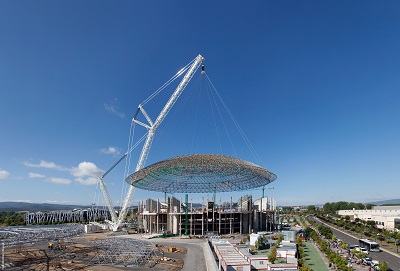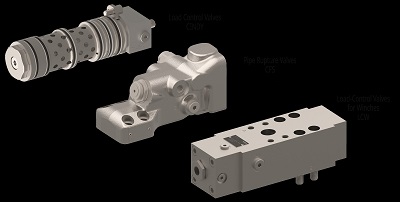Bucher Hydraulics is expanding its portfolio of safety valves with a new load-control valve for winches, as well as additional sizes of other load-control valves and pipe-rupture safety devices.

When a crane must position enormous wind-turbine rotor blades or entire building roofs with millimeter accuracy, valves from Bucher Hydraulics are often used — especially when dealing with heavy loads. To address the growing need, the hydraulics specialists are expanding their already wide range of safety load-control valves. The CINDY follower principle (see Safe and reliable control of large flows) which has been tried and tested for decades, continues to play an important role.
“We have expanded our range of load-control valves with the new LCW version, developed specifically for winch applications,” said René Müller, product manager – Safety Valves at Bucher Hydraulics, Neuheim, Switzerland. LCW stands for Load-Control Valve for Winches. Also new to the product portfolio is the Compact Flow Control and Safety Valve (CFS), a size 25 pipe-rupture valve with a flat design.
Functional integration
“The pilot pressure bypass formerly needed a separate line. With the new LCW, we have succeeded in integrating it into the return line of the winch load-control valve,” said Müller. This saves costs during installation because OEMs have to install fewer components, and it reduces piping requirements. In addition, the LCW is characterized by particularly sensitive and responsive starting behavior — important when it comes to positioning the heaviest loads with millimeter precision.
Another key aspect in light of rapidly rising energy costs is optimized energy efficiency, due to decreased throttling losses during lifting as well as to reduced pressures and pressure peaks during lowering.
Basically, safety valves protect man and machine, thanks to the fact that — depending on the relevant standards — applications rely on load-control valves or pipe-rupture safety devices. If heavy loads have to be precisely moved, held and positioned, or if work access platforms have to hold their position and withstand large forces, safety valves from Bucher Hydraulics are a good choice, said Müller. Among the reasons, CINDY technology is a long-proven concept for safety valves in modular systems. And the valves offer a high opening ratio of 113:1. This results in small changes in pilot pressure for widely differing loads. Operators note that the joystick provides load-independent and responsive travel behavior. Low pilot pressure minimizes the energy required for lowering. For the end user, better energy efficiency saves operating costs.
“In addition, the bypass check valve, which is functionally integrated in a coaxial valve assembly, means a significantly smaller installation space for the valve,” he said. Common safety valves close by means of spring force, which means that safety depends solely on the spring. Depending on the cylinder pressure, considerable forces can be applied to the spring, which is why this type of valve has an inherently lower level of safety. “CINDY valves, on the other hand, close due to the load pressure applied to the valve, which ensures maximum safety,” said Müller.
Multiple combinations
CINDY valves are designed to lift, hold and lower. Installation types include SAE flange mounting, manifold mounting and cartridge designs. Valves with SAE flanges are available up to size 32 and allow a flow rate up to 1,200 l/min (317 gpm). The manifold-mounting version is available up to size 25 and has a maximum flow rate of 500 l/min. The cartridge design has a maximum size of 40, and it operates at a maximum 1,300 l/min flow.
Maximum operating pressure for all variants is 420 bar (6,092 psi), which represents a design safety factor of 3. In line with the modular system concept, these three installation types can be equipped with various operating/control options for a wide range of applications. In addition, the system can be adapted quickly and easily to meet customer-specific requirements.
Pipe-rupture protection

In the event of a pipe or hose burst, pipe-rupture safety devices prevent uncontrolled lowering movements. The relevant standards (EN 474 and ISO 8643) require this type of valve for machines working under certain conditions. For example, excavator pipe-rupture valves are required whenever a lifting device such as a load hook is attached to the excavator bucket, and it can be used to lift a load of more than one metric ton. “As a general principle” said Müller, “work machinery must be equipped with pipe-rupture safety devices on actuators where dangerous situations for people can occur.” This includes equipment for materials handling and demolition/dismantling.
On an excavator, for instance, the standards refer to boom cylinders as well as stick and adjusting cylinders. In the event of a pipe or hose burst, a vertical lowering speed of 150 mm/s at the bucket (the specification for burst tests) may at most double. “Our CFS pipe-rupture valve for excavators goes well beyond this standard. It keeps the lowering speed virtually constant,” he said. Also important: the falling speed of the load must not exceed 10 mm/s in the holding position. “Because our excavator pipe-rupture valves are leak-free, we exceed this requirement.”
The valve must mount directly on the cylinder — without any hose or pipe in between. However, the gap between the excavator superstructure and the boom cylinder is often quite narrow in relation to the hose peripherals or the maximum deflection of the boom, and there is a risk of collision. The flat design of the CFS saves decisive millimeters that eliminate the need for any alteration to the excavator’s design, or even any modifications when this safety device is retrofitted.
The CFS valves also have an integral secondary pressure relief valve to protect the actuators against overload. The actuator and inlet connections are standard SAE flanged ports, and the valves can therefore be retrofitted to existing machines without difficulty. Variations in load pressure — even up to the maximum — have no effect on the fine-control characteristics and hydraulic performance of the valve. In addition, the valve holds the actuator in its position when the main valve is centered.
Functionally safe
The large opening ratio of 480:1 delivers load-independent operation. The guaranteed closing force, even in the event of spring breakage, provides a high level of safety for operator and machine if there is a malfunction, noted Müller.
Because the CFS pipe-rupture safety devices do not contain dynamic seals, hysteresis is low and the setting remains constant. Balanced load-lowering significantly reduces wear on the cylinder and ensures long service life as well as precise, finger-tip controllability. “Even enormous loads can be positioned with millimeter accuracy,” he said.
The CFS pipe-rupture safety valves are available in three sizes: 16 (SAE 0.75 in., 6,000 psi, 250 l/min), 20 (SAE 1 in., 6,000 psi, 350 l/min) and 25 (SAE 1.25 in., 6,000 psi, 600 l/min). In its standard design, the CFS weighs half as much as most comparable products on the market. Thanks to zinc-nickel plating, all valves meet exacting requirements for corrosion protection in harsh working environments.
If standard models are not adequate, Müller says that the experts at Bucher Hydraulics welcome inquiries for customized versions. “Our expertise and services range from development, including simulation, through manufacturing and assembly using the latest technology and final hydraulic testing of each valve, to commissioning and acceptance on site at the machine manufacturer’s facility,” he said.
Bucher Hydraulics
www.bucherhydraulics.com

